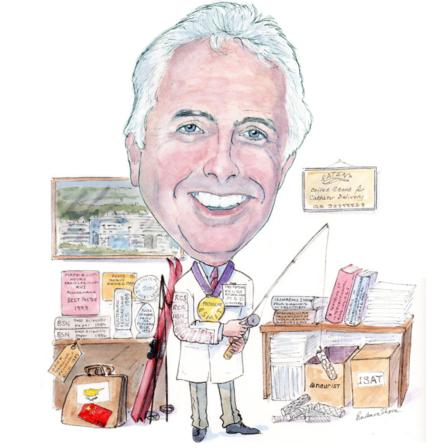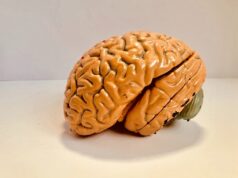
James Byrne, professor of Neuroradiology, University of Oxford, Oxford, UK, was the first neuroradiologist to use the Guglielmi detachable coil in the UK and was involved in the International subarachnoid haemorrhage aneurysm (ISAT) trial alongside Andrew Molyneux. He now tells NeuroNews about the use of the coil changing treatment methods for intracranial aneurysms, his teaching methods at Oxford University and his interests outside of medicine.
What first drew you to medicine and interventional neuroradiology?
These were two very different events. I wanted to be a doctor at the age of 12 and persisted with that ambition through high school. It was a bit of one track thinking that gathered momentum as I discovered the natural sciences, I found I was, and I am still, in awe of the body and its workings.
As for interventional neuroradiology, that was an accidental discovery after I started work as a neuroradiologist. By accidental, I mean I did not initially set out to go into the discipline. I discovered interventional neuroradiology because my hospital needed an interventional neuroradiology service and it was suggested that I should seek training in this area.
Who were your mentors and what wisdom did they impart to you?
I have come across several people in medicine whom I admire, generally because of their approach to patients and colleagues. Someone who I thought was outstanding intellectually was Ruth Bowden, professor of Anatomy at the Royal Free Hospital Medical School. I worked in her department for a year doing anatomical dissections. She taught me the value of critical reading and precise description. I first trained in neurosurgery and switched to neuroradiology for various reasons, but Dick Hoare, a legendary neuroradiologist at the Maudsley, Guys and Great Ormond Street Hospitals, was my mentor in this process. He enjoyed his work and was so good at it that the rewards of excellence were obvious to all who came across him.
Which innovations in neuroradiology have shaped your career?
This is easy, the coil. I went to San Francisco in 1988 on a travelling scholarship awarded by the Royal College of Radiologists. The interventional neuroradiologist at UCSF Medical Centre was Grant Hieshima, who was using detachable balloons to treat aneurysms. He told me that in Los Angeles someone was working on a device that you could place in the aneurysm, retrieve and reposition before detaching by simply pressing a button. This sounded like magic compared to the complexity of balloon delivery, so when Guido Guglielmi came to London in 1990, I made sure I was introduced to him. He is a very generous man who invited me to visit his laboratory the following year. We have been friends ever since.
After training with Guido Guglielmi using the Guglielmi detachable coil, you were the first to use the coil for the treatment of intracranial aneurysms in the UK, please could you describe this experience?
The process involved a series of governance steps, which seemed straight forward at the time. I think it would be more complex and difficult today. The first patient is a crucial leap because it is like a pilot flying solo for the first time. This was made easier because of the experimental work I was conducting here in Oxford. By the time I was cleared to use the device clinically, I had deployed dozens of coils in the laboratory and was familiar with the problems of the early designs.
Please describe one of your memorable cases.
I remember the first time I used image guidance to pass the brain needle into an abscess. Cerebral abscess is a condition that CT revolutionised with immediate improvements in patient outcomes. My switch from neurosurgery was influenced by the realisation that without image guidance, the surgeon’s view is limited because intracranial resections so often involved a “mining process” during which the operator is unaware of what is a millimetre beyond the sucker tip.
What is your proudest achievement in neuroradiology?
I think being part of a discipline that attracts so many interesting people. We help doctors to get the right diagnosis for their patient which helps them provide the right treatment.
What developments in neuroradiology have had an impact on the specialty recently?
This is too big a question for me. The field continues to expand with a seeming insatiable appetite for central nervous system imaging for such a wide range of conditions.
As course director of the Department of Neuroradiology at the University of Oxford, one of the world leading courses in interventional neuroradiology, how would you describe teaching style when training young doctors?
We train using a combination of tutorial theoretical teaching and a surgical apprenticeship. The former is based on the Oxford University tutorial system of one-to-one or small group tutorials. This gives the student time to assimilate and order data. The practical training is organised so that a student works with one clinical tutor as an assistant over a two to three month period. These attachments are rotated so that they see how different operators tackle the challenges of endovascular treatments. As with all medical training, students are encouraged to take personal responsibility for the patient’s management, under careful supervision. They often come with little experience of patient care beyond the angiogram room. The specialty will never develop independently of neurosurgery or neurology, if trainees are not taught the clinical skills needed for patient selection and post-operative care.
Our training is organised around the MSc course in endovascular neurosurgery and interventional neuroradiology. This is a 12-month course leading to a higher university degree. The degree is awarded after students pass examinations, both written and viva voce, and complete a structure curriculum of instruction.
Your areas of scientific interest include endovascular treatment for neurovascular intracranial aneurysms in ISAT (International subarachnoid aneurysm trial). What is the importance of the trial?
I think this was answered in the profile of Andy Molyneux (issue seven of NeuroNews). I think that coil embolization would have developed as a main line treatment without the trial but that it would undoubtedly have been a slower and more cumbersome development.
What were the major outcomes of your study on retreatment of ruptured cerebral aneurysms from the ISAT trial?
The value of that paper was that it quantified the problem. [The trial concluded that patients with ruptured intracranial aneurysms who were eligible for both endovascular coiling and neurosurgical clipping were more likely to survive at one year than neurosurgical clipping].
How do you see the interventional neuroradiological field developing in the future?
The natural process is for the specialty to become a mainstream medical subspecialty. But this is a challenge confronting all the medical specialties as the traditional boundaries are eroded by sub-specialisation. I think it will take place slowly and stepwise. The current emphasis on practitioners demonstrating competency to be licenced to perform a repertoire of procedures will be how hospital services develop. This will allow local solutions to the problem of how interventional neuroradiology fits in a medical community.
What advice would you give to neuroradiologists just starting out in the field?
You are joining an expanding discipline. It is very unlikely that your job will be the same in 10 years time. Therefore be ready to adapt.
What are your interests outside of medicine?
I have a wonderful family who have had to put up with medicine and me. They have kept me safe as a human being. As for recreation, I enjoy fishing, sailing and skiing.
Fact file
Current positions
Professor of Neuroradiology, Medical Sciences Division, University of Oxford, Oxford, UK
Consultant Neuroradiologist, Oxford Radcliffe Hospitals NHS Trust, Oxford, UK
Hospital appointments
2004 Honorary consultant Neuroradiologist, Nicosia General Hospital, Cyprus
1998 Honorary consultant Neuroradiologist, Southampton University Hospital
1998 Temporary License to Practice Medicine in China, granted Beijing Hospital
1997–1998 Honorary consultant Neuroradiologist, Addenbrooke’s Hospital, Cambridge
1989–1991 Honorary consultant Neuroradiologist, Royal Marsden Hospital, London
1988–1991 Consultant neuroradiologist, St George’s Hospital Medical School
Academic appointments
1991–2006 Senior clinical lecturer in Neuroradiology, University of Oxford
1999–2000 Hunterian professor, Royal College of Surgeons of England
1997–1999 Honorary senior lecturer in Radiology, University of Oxford
1998–1991 St George’s Hospital Medical School, University of London
1976–1977 Lecturer in Anatomy, Royal Free Medical School, University of London
Education
1991 University of London, Degree: MD
1985 Royal College of Radiologist, London, FRCR
1979 Royal College of Surgeons, England, FRSC
1974 St Mary’s Hospital Medical School, University of London, and training, MB BS
Membership and committees
2010–2012 President, European Society of Minimally Invasive Therapy
2008–2010 General Secretary, European Society of Minimally Invasive Therapy
2009 Treasurer, British Society of Neuroradiologists
2000–2005 Chairman and UK delegate; Council of National Delegates
2000–2005 Committee member; ESNR Interventional Neuroradiology and Examinations
2000–2005 Committee member; Board of the European Society of Neuroradiology
2005–2011 Member-at-large: World Federation of Interventional and Therapeutic Neuroradiology













